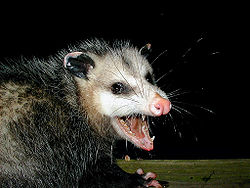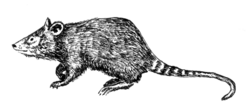AY Honors/Marsupials/Answer Key
1. Distinguish:
a. Mammal from other animals.
The mammals are the class of vertebrate animals characterized by the presence of mammary glands, which in females produce milk for the nourishment of young.
b. Placentals, marsupials and monotremes from one another.
- Placentals
- The placentals are distinguished from other mammals in that the fetus is nourished during pregnancy via a placenta.
- Marsupials
- Marsupials are mammals in which the female typically has a pouch (called the marsupium) in which it rears its young through early infancy. They differ from placental mammals in their reproductive traits.
- Monotremes
- Monotremes are mammals that lay eggs instead of giving birth to live young like marsupials and placental mammals.
2. Understand how marsupials are classified into families and describe, in a general way, the habits of these families.
Opossums
Oppossums are nocturnal marsupials found in the Western Hemisphere. They are small to medium-sized creatures, about the size of a large house cat. Although there are many exceptions, most of them spend time living both in trees and on the ground, and they eat many different things (plants and animals).
Opossums are usually nomadic, staying in one area as long as food and water are easily available. Though they will temporarily occupy abandoned burrows, they do not dig or put much effort into building their own. They favor dark, secure areas, below ground or above.
When threatened or harmed, they will "play possum", mimicking the appearance and smell of a sick or dead animal. The lips are drawn back, teeth are bared, saliva foams around the mouth, and a foul-smelling fluid is secreted from glands. This response is involuntary, rather than a conscious act. Their stiff, curled form can be prodded, turned over, and even carried away. Many injured opossums have been killed by well-meaning people who find a catatonic animal and assume the worst. If you find an injured or apparently dead opossum, the best thing to do is leave it in a quiet place with a clear exit path. In minutes or hours, the animal will regain consciousness and escape quietly on its own.
Shrew opossums
Shrew opossums (also known as rat opossums) are about the size of a small rat (9–14 cm long), with thin limbs, a long, pointed snout and a slender, hairy tail. They are largely meat-eaters, being active hunters of insects, earthworms and small vertebrates. They have small eyes and poor sight, and hunt in the early evening and at night, using their hearing and long, sensitive whiskers to locate prey. They seem to spend much of their lives in underground burrows and on surface runways.
Largely because of their rugged, inaccessible habitat, they are very poorly known and have traditionally been considered rare. Recent studies suggest that they may be more common than had been thought.
3. Describe the distribution, habitat (ie. type of country they live in), diet breeding behavior, as well as any other interesting information of twelve different groups of marsupials and monotremes.
4. Be able to explain the difference between marsupial reproduction and that in true mammals (ie. placentals).
The pregnant female marsupial develops a kind of yolk sack in her womb which delivers nutrients to the embryo. The embryo is born at a very early stage of development (at about 4-5 weeks), upon which it crawls up its mother's belly and attaches itself to a nipple (which is located inside the pouch). It remains attached to the nipple for a number of weeks. The offspring later passes through a stage where it temporarily leaves the pouch, returning for warmth and nourishment.
The placenta is a temporary organ composed of two parts, one of which is part of the fetus, the other part of the mother. It is implanted in the wall of the uterus, where it receives nutrients and oxygen from the mother's blood and passes out waste. This interface forms a barrier, the placental barrier, which filters out some substances which could harm the fetus.


